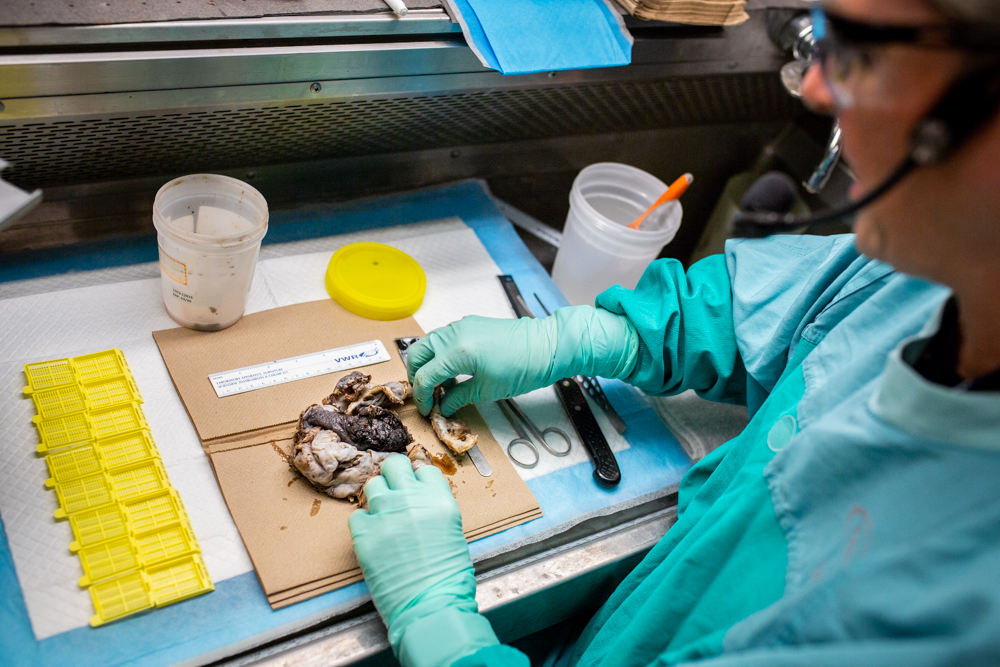A Pathologist Assistant in Histology performs a gross examination of a tissue specimen that has come from the operating room.
Up Close: Medical Laboratory
Laboratory professionals are integral members of the health care team. Up to 85 per cent of medical decisions are based on medical laboratory results. The expertise and dedication of nearly 700 employees across Hamilton Health Sciences’ and St. Joseph’s Healthcare Hamilton’s labs contribute significantly to the ability to provide excellent care for our patients.
The labs perform more than 33,000 tests daily. There are 2,500 different tests that can be done on virtually any body fluid or tissue, bringing new challenges and surprises every day. Get Up Close with our labs here:
Close
These blood culture bottles are received in the laboratory and will be incubated in the BacT/Alert analyzer to detect if a patient has a bacterial infection in their blood (sepsis).
1 of 17
Sample preparation is being completed in the Biological Safety Cabinet which protects the worker from any potential infectious material in the sample.
2 of 17
Blood cultures are loaded on to the BacT/Alert analyzer. The BacT/Alert can hold up to 3800 bottles at a time.
3 of 17
Chromogenic media specifically screens for MRSA and VRE (MRSA = Methicillin Resistant Staphylococcus aureus; VRE = Vancomycin Resistant Enterococcus). All patients in hospital are screened for both MRSA and VRE to help prevent the transmission of these 2 resistant organisms to other patients. This media allows for the detection of both organisms at the same time; if positive for MRSA, pink colonies can be seen on the clear side of the plate. If positive for VRE, colonies are seen on the cloudy side of the plate.
4 of 17
This is blood agar growing bacteria. Each spot represents one colony. Single colonies are selected from this plate and further work is performed to identify the specific type of bacteria and to determine which antibiotics will be effective against the bacteria to help cure the infection.
5 of 17
A Pathologist Assistant in Histology performs a gross examination of a tissue specimen that has come from the operating room.
6 of 17
A Pathologist Assistant takes measurements during a gross examination of tissue.
7 of 17
A closer view of the gross dissection of a tissue specimen.
8 of 17
A Medical Laboratory Technologist multiple pieces of tissues into wax moulds to form a wax block that will have thin sections cut from it to produce tissue slides.
9 of 17
Medical Laboratory Technologists embed multiple tissues (patient specimens) into wax moulds.
10 of 17
Medical Laboratory Technologists inspects the tissue picked up from the waterbath prior to staining.
11 of 17
A Medical Laboratory Technologist cleans the microtome knife of her microtome.
12 of 17
Special stain bench showing multiple reagents used when performing ancillary staining on slides to aid the Pathologist in diagnoses.
13 of 17
After the appropriate amount of incubation, a picture is taken of the plates. The technologist can then view the picture digitally on the monitor to determine if further workup is required.
15 of 17
After the appropriate amount of incubation, a picture is taken of the plates. The technologist can then view the picture digitally on the monitor to determine if further workup is required.
16 of 17
The technologist makes a suspension of bacterial colonies for susceptibility testing to determine which antibiotics the particular bacteria is sensitive to.
17 of 17
Previous Next
If you enjoyed this photo set, have a look at other collections in the Up Close series:
Biomedical Technology
Open Heart Surgery
Trauma Team Response

